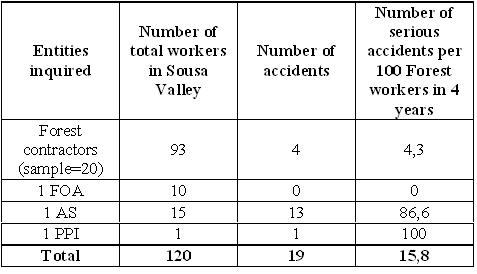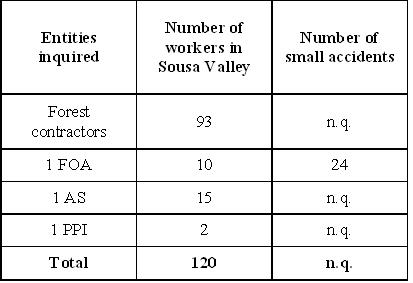Percentage of the total forest area in Sousa Valley: 100 %
Costs
TOTAL COST: 280,6 €
The total cost includes:
1-Data collection
190,6 €
2-Data analysis
90 €
Results
Number of serious accidents per 100 forest workers in [2003 -2006]
Source: Phone inquiries to local timber merchants
Number of small accidents per 100 forest workers in [2003-2006]
Source: Phone inquiries to local timber merchants
FOA- Forest Owner Organisation
AS- Agricultural society
PPI- Pulp and paper industry
n.q. – non quantified
Remarks
Data report occupational accidents occurred in Forestry and Forest logging in the period 2003-2006 in the 6 municipalities of Sousa Valley mainly for the forest workers employed by forest contractors and timber merchants.
It was also considered the forest sappers employed by the Forest Owners Association of Sousa Valley (AFVS), the supervisors of one pulp and paper industry with forest area in Sousa Valley and the forest workers employed by one agricultural society. The total number of forest workers covered by this indicator is 120, being 93 employed by forest contractors and timber merchants and 27 employed by other entities. The number of occupational accidents is given per 100 forest workers and it is divided in two categories: serious accidents and small accidents.
It were considered as serious accidents the injuries that have to be treated at the hospital, putting the worker without capacity to work for more than 8 days or even for the rest of his life. In the period 2003-2006 forest workers in Sousa Valley had suffered 19 serious accidents which gives a rate of 15,8 occupational accidents per 100 forest workers. However, it can be pointed that if the analyse were done according to the type of entities inquired (timber merchants/forest contractors or others) the rates would be very different: the rate of occupational accidents per 100 forest workers is low for timber merchants and forest contractors as well as for the FOA compared to the rate of occupational accidents occurred with forest workers of the SA.
Wounds, muscular distensions or scratches were considered as small accidents. For this type of accidents most of the timber merchants and forest contractors did not quantified the right number even though they had admitted their existence. Some of them assured that these small accidents do not put workers out of work for more than 1 week.
The FOA was the only entity contacted where these small accidents were registered.
Some of the forest lodging enterprises inquired assured that because they provide services to the pulp and paper industries they are obliged to follow the laws of security and hygiene in work, reducing the risks of occupational accidents among their forest workers.
Others stated that the reason why they never have serious accidents is more a matter of luck than of following or not the rules of security and hygiene in work.
Shortcomings and improvements
The production of statistical information about occupational safety and health is based on the system of repair (Sistema de reparação) settled in the Insurance Companies (Companhias de Seguros), framed by the constant juridical regime of the Law no 100/97, of 13th September and by the Law no 143/99, of 30th April, which regulate it. The information results from the collection, validation and treatment of the constant data of the participations, sent to the Insurance Companies, referring to the moment of the accident occurrence and the maps of closing of the process. Before 2005, only the enterprises with more than 100 workers were obliged to inform the official entities about the number of occupational accidents per year. At the national level, the number of occupational accidents in the forest sector is included in the occupational accidents of Agriculture, animal production, hunting and forestry and is not broken up at regional level and at a lower level of activity’s classification. In Sousa Valley, the enterprises employing forest workers are mostly small enterprises employing between 3 and 5 workers, a number much below the 100 workers and so far these enterprises were not obliged to inform the official statistics about occupational accidents they have had.
Data had to be checked at the local level using several sources, namely the local FOA which put available the contacts of a group of timber merchants and forest contractors who are the main employers of forest workers. Some of the timber merchants contacted provided information about other timber merchants they know. The pulp and paper industries and the foresters working in the field were also contacted. According to local sources, the number reaches about 80 timber merchants and forest contractors employing forest workers in Sousa Valley. The sources contacted could only provide information about 20 of them. These 20 employers were the ones inquired about the occupational accidents of their workers. Data reliability depends on the sincerity of timber merchants and forest contractors. Since no official entities ask for this type of data they do not feel obliged to tell the truth.
In order to improve data, the list of contacts of timber merchants and forest contractors can be increased through the collaboration of the timber merchants and forest contractors inquired under FORSEE project and for whom the contacts are already available.
Comments and conclusion
To be an indicator able to be monitored in the future it will be needed to record the contacts of the timber merchants and forest contractors inquired and to ask them periodically to quantify the number of occupational accidents they have had in a stated period. The timbers merchants inquired during FORSEE project can be maintained and some can be added through the information given by the formers. In order to reach them, a list of contacts is already provided in FORSEE Methodology Report.
This indicator is important for SFM since the right management of the forest also depends on the good working conditions of the managers and other forest workers.
Occupational accidents is one of the indicators of Criterion 6 considered by NP 4406 2003. NP 4406 2003 states that forest activities, by the characteristics they have, are under a high risk when compared with other activities. However, there are several codes of health and work security that, when accomplished by the workers and forest contractors, contribute to reduce or even to finish the number of accidents and mainly the number of serious accidents.



Initiative Communaitaire FEDER
INTERREG IIIB Espace Atlantique

